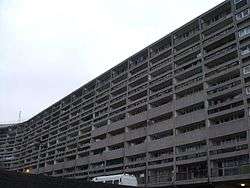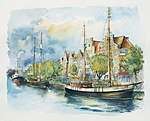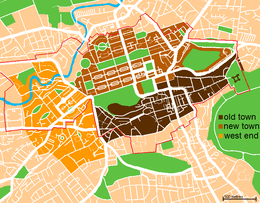Leith
Leith (/liːθ/; Scottish Gaelic: Lìte) is a port area in the north of the city of Edinburgh, Scotland, at the mouth of the Water of Leith.
Leith
| |
|---|---|
 Aerial view of Leith and the Firth of Forth | |
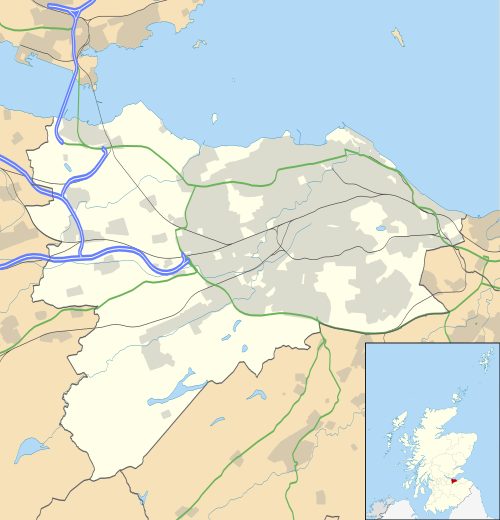 Leith Location within Edinburgh | |
| Population | 50,030 (2011) |
| Council area |
|
| Lieutenancy area | |
| Country | Scotland |
| Sovereign state | United Kingdom |
| Post town | EDINBURGH |
| Postcode district | EH6 |
| Dialling code | 0131 |
| Police | Scotland |
| Fire | Scottish |
| Ambulance | Scottish |
| UK Parliament | |
| Scottish Parliament | |
The earliest surviving historical references are in the royal charter authorising the construction of Holyrood Abbey in 1128.[1][2] The medieval settlements of Leith had grown into a burgh by 1833, and the burgh was merged into Edinburgh in 1920.[3]
Leith is located on the coast of the Firth of Forth and lies within the City of Edinburgh.
History
The earliest evidence of settlement in Leith comes from several archaeological digs undertaken in the Shore area in the late 20th century. Amongst the finds were medieval wharf edges from the 12th century. This date fits with the earliest documentary evidence of settlement in Leith - the foundation charter of Holyrood Abbey.
Leith has played a long and prominent role in Scottish history. As the major port serving Edinburgh, it has been the stage on which many significant events in Scottish history have taken place. Mary of Guise ruled Scotland from Leith in 1560 as Regent while her daughter, Mary, Queen of Scots remained in France. Mary of Guise moved the Scottish Court to Leith, to a site that is now Parliament Street, off Coalhill. According to the 18th-century historian William Maitland, her palace was situated on Rotten Row, now Water Street. Artifacts from the demolished residence are held by the National Museum of Scotland, and her sculptured coat of arms, dated 1560, can be seen in South Leith Parish Church. When the large French garrison stationed in Leith was attacked by Scottish Protestant lords, reinforced by troops and artillery sent from England, Mary of Guise was forced to shut herself in Edinburgh Castle. In June 1560, Mary of Guise died, and the Siege of Leith ended with the departure of the French troops in accordance with the Treaty of Leith, also known as the Treaty of Edinburgh.
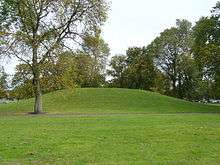
Two mounds on Leith Links, known as "Giant's Brae" and "Lady Fyfe's Brae", identified as Somerset's Battery and Pelham's Battery respectively, are believed to be artillery mounds created for the siege in April 1560 and are listed as scheduled monuments. Stuart Harris was of the opinion, based largely on the contemporary Petworth map, that Pelham's Battery was built on the slope to the south of Leith Links and Somerset's Battery was located adjacent to the present Pilrig House. He also notes that the "tradition" that these batteries were situated on Leith Links is spurious, going no further back than Campbell's "History of Leith" 1827. Lent authority by the Ordnance Survey map of 1852, this attribution saved the mounds when several other hillocks on the links were removed in the 1880s.[4] The best documented day of the siege was 7 May 1560, when the English and Scots charged the walls of Leith with ladders that turned out to be too short. John Knox records the delight of Mary of Guise at the failure of the attack, and English sources report 1000 casualties.[5]
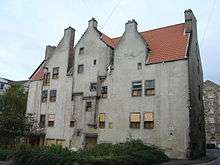
Late in 1561, Mary, Queen of Scots, arrived in Leith and, finding no welcoming party to receive her, made a brief stop at the "house of Andro Lamb ... beit the space of ane hour", before being collected and escorted by coach to Holyrood Palace, to begin her ill-fated six-year-long reign.
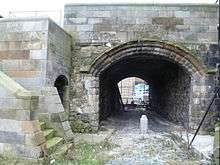
After the abdication of Mary Queen of Scots in 1567, during the ensuing civil war, troops fighting for James VI of Scotland against his mother's supporters in Edinburgh Castle based themselves in Leith from 1571–1573, a period called the "Wars between Leith and Edinburgh". In January 1581 the Shore was the scene of a mock combat, involving an assault on the Pope's Castel Sant'Angelo built on boats, for the marriage of Elizabeth Stuart, 2nd Countess of Moray and James Stewart for the entertainment of guests including James VI.[6] In 1590, James's Anne of Denmark was lodged in the King's Wark when she arrived.[7]
In 1650, Leith was a prospective battleground when the Army of the Covenant, led by General David Leslie, threw up an earthen rampart between Calton Hill and Leith to defend the northern approach to Edinburgh against Oliver Cromwell's forces. This rampart became the line of one of Edinburgh's longest streets, Leith Walk. After Cromwell's victory at the Battle of Dunbar in 1650 and subsequent occupation of Scotland, a fort known as Leith Citadel was erected in 1656 to regulate the port traffic. All that remains of the fort today is a vaulted trance in Dock Street which was its main entrance.
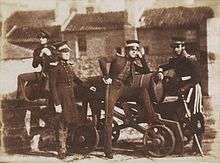
During the American War of Independence the Scot, John Paul Jones, who, with John Barry, is credited as founder of the US Navy, set sail on 14 August 1779 as commodore of a squadron of seven ships with the intention of destroying British commerce in the North Sea. He intended to capture the port of Leith and hold it for ransom, but his plan was thwarted when a gale on 16 September kept him at the mouth the Firth of Forth. The scare he caused led to the hasty erection of Leith Fort, designed by James Craig, the architect of Edinburgh's New Town, and built in 1780. A Georgian terrace to the north-east served as officers' quarters, and was known as "London Row" because, being brick-built, it looked more like a London terrace than any in Edinburgh. The fort was in active use until 1955, latterly serving for National Service training. Most of the barracks were demolished to build a Council housing scheme centred on Fort House and enclosed by the old fort walls. The Council development was an award-winning scheme in its day (1955), but the building was demolished in January 2013 and the site is to be redeveloped. A pair of the old fort's gatehouses survive at the southern entrance to the scheme.
From the twelfth century South Leith was part of the parish of Restalrig and had no church of its own. After the Scottish Reformation the principal parish kirk for Leith was South Leith Parish Church, originally constructed in 1483. In June 1811 a statistical population census gave the population of South Leith as 15,938; North Leith 4,875. With a procession and ceremony, the foundation stone of the new church for the parish of North Leith was laid on 11 April 1814.[8]
Leith was the port of entry for the visit of King George IV to Scotland, and The Old Ship Hotel and King's Landing was then given its new name, to mark the King's arrival by ship's boat at Leith Shore for this event, and this Monarch was welcomed by the High Constabulary of the Port of Leith (Leith High Constables). A painting of the occasion hung in Leith City Chambers, now Leith Police station.[9]
Leith Docks became known as the port for Edinburgh and modest shipbuilding and repair facilities grew. On 20 May 1806, there was a procession of the Lord Provost of Edinburgh, Baillies, and Council, along with a numerous company of ladies and gentleman, for the opening of the first new Wet Dock, the first of its kind in Scotland. The Fife packet called The Buccleuch was the first to enter the dock, with the civic dignitaries on board, amid discharges of artillery from the Fort and His Majesty's warships in Leith Roads. The foundation stone for the second (middle) wet dock was laid on 14 March 1811, which was completed and opened with due ceremony in 1817 by Lord Provost Arbuthnot. The same year the Trinity House in Kirkgate was erected in Grecian architectural style at an expense of £2500.[10] During the 19th century Leith became an important entrepôt for the Scottish herring trade, with exports peaking at 388,899 barrels in 1907.[11]
The docks at Leith underwent severe decline in the post-Second World War period, with the area gaining a reputation for roughness and prostitution, with an official 'tolerance zone' until 2001. In recent years, Leith has undergone significant regeneration and is now a busy port with visits from cruise liners and the home of the Royal Yacht Britannia, Ocean Terminal, and administrative offices for several departments of the Scottish Government. The council and government's 'Leith Project' provided a further economic boost. The shore area of Leith, once unattractive, is now a centre for a range of new pubs and restaurants in charming surroundings. On 6 November 2003, Leith was the location for the MTV Europe Music Awards, with a temporary venue being built next to Ocean Terminal.

Historically Leith was governed by the Town Council of Edinburgh, with separately organised baillies appointed by various bodies without contact with each other. The result became very unsatisfactory, and half of Leith was provided with no municipal government whatever or any local magistrates. An 1827 Act of Parliament arranged for municipal government and administration of justice in the town, providing watching, paving, cleansing, and lighting, with Edinburgh Council responding to the views of Leith townspeople. In 1833 the Burgh Reform Act made Leith a Parliamentary Burgh, which jointly with Portobello and Musselburgh was represented by one member of Parliament. On 1 November 1833, Leith became a separate Municipal Burgh, with its own provost, magistrates, and council, and was no longer run by bailies.[12] Historically the Lord Provost of Edinburgh was virtue officii Admiral of the Firth of Forth, the Provost of Leith was Admiral of the port, and his four bailies were admirals-depute.[13]
Emperor Nicholas II of Russia arrived by sea at Leith with his family and suite on Tuesday 22 September 1896.[14] Scottish anarchist Thomas Hastie Bell managed to get in his face to criticize him.[15]
Leith was the scene of the Dockers strike in 1913[16][17][18] recounted in the book Red Scotland[19]
Continued growth meant that Leith and Edinburgh formed a contiguous urban area. Leith was merged with Edinburgh in 1920 despite a plebiscite in which the people of Leith voted 26,810 to 4,340 against the merger.
Until 1923 there was no through tram service between Leith and Edinburgh; at the boundary in Leith Walk it was necessary to change from a Leith tram (electrically powered) to an Edinburgh tram (cable hauled) until the electrification of the Edinburgh Corporation Tramways in the early 1920s.
Traditional industries
Leith was Scotland's leader in several industries for many centuries. Of these the most notable are:
- Glass – the Leith Glassworks stood on Baltic Street and dated from 1746. There is also some reference to earlier glass production from 1682, but the site of this earlier works is unclear.[20] Leith specialised in wine bottles, largely for export to France and Spain. At its peak (c.1770) production was a staggering one million bottles per week. The Leith pattern bottle is the parallel-sided, round shouldered, narrow neck bottle now dominant within the wine industry. Around 1770 the company branched into lead crystal glass, mainly for chandeliers. This was under a new company name of the Edinburgh Crystal Company but stood on the same site in Leith (ironically this company has never truly been in "Edinburgh").
- Soap – the Anchor Soapworks was established on Water Street around 1680. This largely used whale oil in its production. This survived until around 1930.
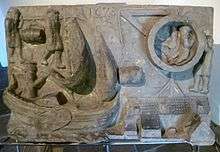
- Whisky production - Sanderson's distillery was based in Leith from 1863, and was famous for its Vat 69 and Mountain Dew scotch blends.[21] The distillery became a limited company in 1896 and was known as William Sanderson & Son Limited. Production moved from Leith to South Queensferry in 1969. Sanderson's is now owned by Diageo.
- Wine and whisky storage – wine storage in Leith dates from at least the early 16th century, notably being connected with the Vaults on Henderson Street from this time. At its peak there were around 100 warehouses storing wine and brandy. In the late 1880s, due to the collapse of wine harvest in Europe, most of these were "converted" to whisky storage. Around 85 bonded warehouses stood in Leith in the 1960s. Jointly these matured around 90% of all Scotch whisky. One of the largest, Crabbies on Great Junction Street, stored whisky for some of the foremost whisky distilleries: Lagavulin, Talisker, Laphroaig etc. The last bond, on Water Street, closed around 1995. An offshoot to the wine industry (for obvious reasons) were several vinegar works. Crabbies also had a famous Green Ginger manufactory alongside its bond.
- Lime juice – Rose's lime juice was founded by Lachlan Rose in Leith on Commercial Street in 1868. This was originally and primarily focussed upon provision of vitamin C to seamen.
- Shipbuilding – originally centred on the Water of Leith and limited in scale due to the shallow water, Leith's shipbuilding started to fade as vessels increased in size. Latterly Leith specialised in odd ship types: tugs, hotel ships, cable-layers etc. Whilst the most notable large shipyard Henry Robb's, closed around 1981 this was technically outlived by a very small shipbuilder on Sheriff Brae (run by the Scottish Co-operative Society) which closed around 1988. The most notable ships built in Leith are the SS Sirius, one of the first steamships to cross the Atlantic, and SS Copenhagen one of the largest rigged ships ever built. Robb's yard also made a great contribution to the RN and MN during the Second World War, building forty-two vessels for the Royal Navy, fourteen merchant ships and refitted and repaired nearly 3,000 ships of the Royal Navy and Merchant Navy. This means that one new ship was launched on an average every six weeks and a ship repaired every day of this long and bloody conflict. The RN list included Flower and Castle Class Corvettes and River, Loch and Bay Class Frigates (see Leith built ships 1939-45).
- Lead – Scotland's largest leadworks stood on the corner of Mitchell Street and Constitution Street. Founded around 1760 the operational part worked until the 1970s and the empty buildings stood until the late 1980s. The offices, on Constitution Street, still survive. The company specialised in lead pipes for water supply and lead drainpipes. They also produced lead sheet for roofing and lead shot for weapons.
- Whaling – originally focussed on local, and Icelandic waters (the last whale in the Firth of Forth was caught in 1834); by the mid 19th century ships were travelling to the Antarctic. In the early 1900s, the Christian Salvesen company developed significant interests in whaling, initially in the Arctic, and then in the Antarctic. Among their many whaling stations in the South Atlantic, they established and operated from a base on the island of South Georgia, south east of the Falkland Islands at Leith Harbour (named for their base in Scotland). South Georgia later came to fame at the beginning of the Falklands War). The company moved from Leith to Fettes around 1980 and then left Edinburgh altogether in the mid-1990s. The founder, Christian Salvesen is buried in Rosebank Cemetery. Whaling ships from Leith brought the very first penguins to Edinburgh Zoo around 1900.
Geography

After decades of industrial decline, deindustrialisation, slum clearance and resultant depopulation in the post-war era, Leith gradually began to enjoy an upturn in fortunes in the late 1980s. Several old industrial sites were developed with modest, affordable housing, while small industrial business units were constructed at Swanfield, Bonnington, Seafield and off Lindsay Road. The Shore developed a clutch of upmarket restaurants, including the first of the chain of Malmaison hotels in a conversion of the former "Angel Hotel", a seaman's mission, whilst the once industrially-polluted and desolate banks of the Water of Leith were cleaned up and a public walkway opened.
Leith's gradual revival was also helped by the decision of the then Scottish Office to site their new offices in Leith Docks (just north of the old infilled East Dock). The site was chosen as part of a design-and-build competition against other sites at Haymarket and Marionville. It was completed in 1994. The hoped for influx of well-paid civil service jobs failed to have much local impact as most commute to the office, and only a small percentage venture beyond the confines of the office during lunchtimes. It did further foster Leith's growing reputation as a white-collar, small business location. Further large-scale service and tourist development followed, including the Ocean Terminal shopping centre and the permanently moored Royal Yacht Britannia. The plan to connect Ocean Terminal and the Scottish Executive building area by the new Edinburgh Trams by the Port of Leith tram stop has been shelved.
In 2004 the owner of the docks, Forth Ports, announced plans to eventually close the port and carry out a major redevelopment of the area.[22] The planned development, which was given supplementary planning guidance by The City of Edinburgh Council in 2004, was a small town with up to 17,000 new homes.[23]
Area
Streets in Leith include Constitution Street, Great Junction Street, Henderson Street, Bernard Street, Leith Walk and Easter Road.
One of the areas is Timber Bush.
Following developments in Edinburgh and following a change of legislation which allowed people to live outside the town walls and still have trading rights[24] an area to the west of the Leith of the end of the 18th century, flanking Ferry Road, was built. Development was sporadic with only certain sections following the original feuing. Many streets are named after events or people of the time:
- Pitt Street, after William Pitt the Younger the then Prime Minister
- Trafalgar Street, after the Battle of Trafalgar (1805)
- Prince Regent Street, after the then Prince George
- Portland Place, Portland Terrace and Portland Street (Albany Street until 1966), after the Duke of Portland
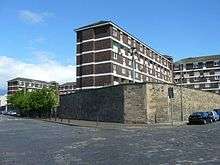
A centrepiece of the whole development was Leith Fort, built along the lines of Fort George in 1780. This was demolished in 1955 having continued to serve a military function until that time. A housing scheme was then built on its site by Edinburgh Council and named Fort House. Two huge 22 storey blocks, Cairngorm and Grampian House on the north edge, survived less long and were removed in the mid-1990s. The main block was demolished late in 2012.
Some equivalent, less structured Georgian development happened on the east side of Leith, again their date evidenced in street names:
- Wellington Place, after the Duke of Wellington
- Queen Charlotte Street, after Charlotte, the consort of George III.[25]
- Elbe Street, after Leith's trading links.
Religion

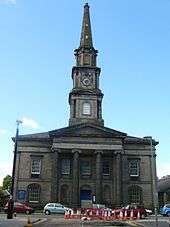
Leith has several notable historic churches, including North Leith Parish Church and South Leith Parish Church (both of the Church of Scotland), and the Roman Catholic St Mary's Star of the Sea. The area has Sikh and Hindu Temples, a Shia Imambargah, a Sunni Mosque and community centre, a Pentecostal centre, a Ukrainian Greek Catholic Church; it also has a former Norwegian Church, which is home now to the Leith School of Art.
Transport
A regular stage coach service ran between Bernard Street and Edinburgh's Old Town from the mid-18th century. By 1863 this had become a horse-drawn omnibus running every 5 minutes from 9 am to 10 pm.[26] This was put on tracks sometime around 1880[27] effectively then becoming a horse-drawn tram. Leith was the first town in Scotland to electrify its tram system (1905).[28] Leith Corporation Tramways were merged into Edinburgh Corporation Tramways as part of the 1920 merger of the two burgh councils.[29] Tram services ran until 1956 and were then replaced by buses due to the contemporary perception of their greater flexibility.
In the mid-nineteenth century the railways came. Leith had one horse-drawn line pre-dating steam-trains, bringing coal from Dalkeith to a station at the north end of Constitution Street, to serve the glassworks there. This dated from the late 18th century. Steam trains arrived in the 1840s, being some of the earliest lines in Britain. When the railways were at their height, Leith had four passenger stations and many goods stations.[30] However, in the 1950s the Beeching report recommended the closure of almost all of Leith's railway infrastructure. Today, only one freight line that connects to the dock remains in use.
Although there are no longer any passenger rail services serving Leith, two station buildings partially remain:
- Leith Central, on the corner of Leith Walk and Duke Street. The station clock, offices and public house (Central Bar) remain.
- Leith Citadel, on Commercial Street. The building is now a youth centre.
The SS Sirius (built in Leith) beat the SS Great Western by one day in being the first steamship to cross the Atlantic but, as a much smaller ship, was eclipsed by the press coverage given to the larger ship. Leith offered ferry services to many European ports, including Hamburg and Oslo.
Today, Leith is served by various bus services provided by Lothian Buses. A tram service was due to serve Leith in 2011 by Edinburgh Trams. However, due to construction and funding issues, the section of the line towards Leith was cancelled. As of 2017, the current administration of the City of Edinburgh Council support plans to complete the line towards Leith.
Culture and community
Leith has a long history of pioneering social advances, some of which were the first of their kind in Scotland:
All boys were educated for free from 1555 onwards. This was paid for by the local trade guilds. All girls were educated from 1820, a long time after the boys, but a very early example of free education for females (only required by law from 1876). A free hospital service was provided from 1777, paid for by a local tax, with beds sponsored by local shops. Leith had electric street lighting from 1890 and electric trams from 1905 (only Blackpool was earlier in the UK). The first public sewer in Scotland was built in Bernard Street in 1780; this flowed into the Water of Leith. The iron seal over the end of the sewer is still visible next to Bernard Street bridge. The sewage is now pumped in the opposite direction (it was laid to fall westwards) to Seafield.
Leith was formerly a port linked to the trade of the Hanseatic League. Today it is a multicultural community with sizeable African-Caribbean, Asian and Eastern European participation. Other historic incomers have included 19th century Irish, Italian immigrants (See Henderson Street) and various refugee groups from the world wars and upheavals of the early 20th century.
Festivals occur throughout the year, including Leith Festival, Leith Late festival,[31] PLU Parents Like Us and the Edinburgh Mela on Leith Links, part of the Edinburgh Festival since 2010. The Leith Gala, now known as Leith Festival Gala Day is an annual event that has taken place since 1907; it was originally a charity event to raise sponsorship for local hospital beds before the National Health came into place. It has developed into the community-based Leith Festival.
Leith FM (later renamed Castle FM) started as a week-long RSL station during the late 1990s, linked to Leith Festival. A few years of annual 28-day broadcasts later, the station bid for and won a permanent community radio licence and broadcast for several years on 98.8 FM and online. In December 2013, Leith Dockers Club locked the station out of its rented premises, due to the "substantial" debt it was owed by the station, and the future of the station is currently in doubt.
Leith is home to Leith Academy, one of the oldest schools in Scotland, and to the Leith School of Art, which along with Glasgow School of Art is one of only two independent art schools in Scotland.
Leith is also home to The Queen's former floating Royal residence, The Royal Yacht Britannia, now a five-star visitor attraction and evening events venue permanently berthed at Ocean Terminal.
Irvine Welsh had his Channel 4 drama Wedding Belles (2007) filmed in Henderson Street. Welsh's novel Trainspotting and its prequel, Skagboys concern a group of drug users living in the Leith area in the 1980s and numerous local landmarks are referenced. Trainspotting Tours take place during the Leith Festival.
Leith Library is on Ferry Road.
Ethnicity
| Leith compared | Leith | Edinburgh |
|---|---|---|
| White | 90.3% | 91.7% |
| Asian | 6.6% | 5.5% |
| Black | 1.2% | 1.2% |
| Mixed | 1.1% | 0.9% |
| Other | 1.2% | 0.8% |
Sport

Leith is the home of Hibernian Football Club which is a member of the Scottish Premiership.
Leith Athletic Football Club have been part of Leith's sporting culture since their foundation in 1887 until closure in 1955. Reformed in 1996 they amalgamated with Edinburgh Athletic in 2008 and achieved promotion to the East of Scotland Premier Division in 2011. They host home games at Peffermill 3G.
Leith Links have been used a sports and recreation area over many centuries.
Leith is significant in the historical development of the rules of golf, as the Honourable Company of Edinburgh Golfers played there before moving to Musselburgh Links and later Muirfield.[32] The official rules of golf, initially formulated at Leith in 1744, were later adopted by the Royal and Ancient Golf Club of St Andrews. The only difference introduced with those rules (which remain the rules of golf) was the omission of one rule to do with hazards such as trenches.
From at least 1600 until 1816, Leith Races were held on Leith Sands, an area immediately north of the present Links and now built over. They were long regarded as one of Scotland's most important horse race meetings before racing moved to Musselburgh permanently from 1816 onwards.
Leith Links also have one of the longest established cricket pitches in Scotland, from 1820.
Former Provosts
Source:[33]
- Adam White (1760–1843), served 1833–1839
- James Reoch (1768–1845), served 1839–1845
- Thomas Hutchison (1796–1852), served 1845–1848
- George Adiston McLaren (1801–1881), served 1848–1851
- Robert Philip (d.1887), served 1851–1855
- James Taylor (1800–1890), served 1855–1860
- William Lindsay FRSE (1819–1884), served 1860–1866
- James Watt (1806–1881), served 1866–1875
- Dr John Henderson (1818–1901), served 1875–1881, instigated the Leith Improvement Plan
- James Pringle FRSE (1822–1886), served 1881–1886
- Dr John Henderson (1818–1901), served second term 1886–1887 following Pringle's death in office
- Thomas Aitken (1833–1912), served 1887–1893
- John Bennet (1820–1902), served 1893–1899
- Sir Richard Mackie (1851–1923), served 1899–1908
- Malcolm Smith (1856–1935), served 1908–1917
- John Allan Lindsay (1865–1942), served 1917–1920, the final Provost of Leith
Famous residents
- William Lindsay Alexander (1808–1884), theologian
- Thomas Anderson (1819–1874), chemist
- John Armstrong (1771–1797), journalist and poet
- Adam Archibald (1879–1957), World War I recipient of the Victoria Cross
- Hugo Arnot (1749–1786), historian, buried in South Leith churchyard
- Andrew Barton (c. 1466 – 1511), privateer, Lord High Admiral of Scotland
- Robert Barton (d. 1540), brother of the above, privateer and Lord High Treasurer of Scotland
- Edith Marian Begbie (1866-1932), militant suffragette and member of the WSPU
- Kenneth Borthwick (1915-2017) Lord Provost of Edinburgh 1977-80, Chairman of the 1986 Commonwealth Games.
- Sir Thomas Jamieson Boyd (1818–1902), Lord Provost of Edinburgh 1877–82
- Eric "Winkle" Brown (1919–2016), test pilot of a record number of aircraft types
- James Brown (1907 – unknown), footballer
- Paddy Buckley, footballer
- John Cheyne, surgeon
- John Chisholm (fl. 1560s), keeper of royal artillery at the King's Wark
- John Coldstream (1806–1863), physician
- Edwyn Collins, musician
- James Scarth Combe (1796–1883), surgeon (first to describe pernicious anaemia)
- David Cousin (1809–1878), architect
- John Crabbie founder of Crabbie's on Great Junction Street
- David Craigie (1793–1866) medical author
- Prof Ernest Cruickshank FRSE nutritionist, and twin brother, Brigadier Martin Melvin Cruickshank FRSE
- Helen Crummy (1920–2011), founder of Craigmillar Festival Society for the local community
- Robert James Blair Cunynghame FRSE, physiologist and forensic scientist
- James Currie (shipowner) FRSE President of the Royal Society of Edinburgh, shipowner and shipbuilder, proprietor of James Currie & Co and the Currie Line (shipping)
- Gordon Donaldson, historian
- Frank Doran, Labour politician
- Handyside Edgar, physician
- Sir Tom Farmer, founder of Kwik-Fit and former owner of Hibernian F.C.
- Dick Gaughan, folk singer
- John Gibson Gibson CB FRSE (1889-1970) physicist and mathematician
- Robert Gilchrist (1821–1905), first-class cricketer
- Dr George Ritchie Gilruth FRSE (1842-1921) surgeon
- John Gladstone, MP and father of William Ewart Gladstone
- Thomas Gladstones, merchant and father of John Gladstone
- Prof John Russell Greig FRSE Director of the Moredun Research Institute
- Leigh Griffiths, footballer
- John Hall, Moderator of the General Assembly of the Church of Scotland, minister of Leith for a time
- Peter Heatly, diver
- John Home (1722–1808), poet and dramatist
- John Hughes (b. 1964), football manager formerly of Falkirk F.C. and Hibernian F.C.
- John Hunter, second Governor of New South Wales
- James Campbell Irons FRSE (b.1840) legal author and historian, author of The Antiquities of Leith
- Robert Jameson (1774–1854), naturalist and mineralogist
- William Jameson FRSE (1815-1882), botanist responsible for the promotion of tea-growing in northern India
- William Johnston, recipient of the Victoria Cross
- Dr George Kellie (1720-1779) surgeon, and his grandson Dr George Kellie FRSE (1781-1829)
- Dr Thomas Latta inventor of saline drip
- David Lindsay (d. 1613), chaplain of James VI of Scotland and Bishop of Ross, buried here
- Harold Mahony, Irish tennis player who had a home at Dalmore Lodge in Leith
- Sam McCluskie, Labour politician and trade unionist
- Andrew Macdonald (poet) born at the foot of Leith Walk
- Very Rev Robert MacDonald (1813-1893) minister of North Leith Free Church, Moderator of the General Assembly of the Free Church of Scotland 1882/83.
- Willie Merrilees, lifesaver and distinguished policeman, later Chief Constable of the Lothians and Peebles Constabulary
- Alexander Morgan (mathematician) FRSE
- James Morton, footballer
- Thomas Morton, shipbuilder and inventor (the patent slip)
- Erskine Nicol RSA (1825-1904) artist
- Eduardo Paolozzi (1924–2005), pop Artist and sculptor
- Charlie and Craig Reid of folk band The Proclaimers
- Very Rev George T. H. Reid, Moderator of the General Assembly of the Church of Scotland 1973/4
- Henry Robb, shipbuilder
- J.K. Rowling, Author
- Clarice Shaw (1883–1946), pioneering woman Labour politician and MP
- John Sligo of Carmyle FRSE (1794-1858) merchant and amateur geologist
- Chris Small, professional snooker player
- Neil Smith, geographer
- Ralph Stockman (1861-1946) and his younger brother Stewart Stockman (1869-1926)
- Danny Swanson, footballer with Peterborough United
- Unicorn Kid (Oliver Sabin, b. 1991), electronic music/chip music composer
- Jordy Deelight, drag artist and DJ
- Irvine Welsh, author, Trainspotting
See also
Notes
References
- "Site Record for Edinburgh, Leith, General North Leith; South Leith Details (Canmore)". RCAHMS. Retrieved 6 March 2012.
- Campbell 1827, p. 2.
- "History". Leith Theatre Trust. Archived from the original on 28 November 2015. Retrieved 11 August 2015.
- Harris, Stuart, 'The Fortifications and Siege of Leith', in PSAS, vol. 121, (1991), 361–62 & fn.21
- Calendar State Papers Scotland, vol. i: HMC Hatfield Manuscripts, vol. i: Sadler Papers, Edinburgh (1809): Forbes Full View, (1740): History of Reformation, John Knox, etc.,
- Calendar State Papers Scotland: 1574-1581, vol. 5 (Edinburgh, 1907), p. 611.
- Calendar State Papers Scotland, vol. 10 (Edinburgh, 1936), pp. 186, 863: David Stevenson, Scotland's Last Royal Wedding (John Donald: Edinburgh, 1997), p. 100.
- Gilbert 1901, pp. 54,58.
- Wood, Andrew Dick (1972). The High Constabulary of the Port of Leith; a short history. Loanhead: Macdonald Printers (Edinburgh) Ltd. ISBN 978-0-9502550-0-2. OCLC 629063.
- Gilbert 1901, pp. 42,64–65.
- "The Scottish Continental Herring Trade 1810-1914". Retrieved 6 June 2016.
- "The Story of Leith - XXXIII. How Leith was Governed".
- Grant, p. 89.
- , to begin his visit to Scotland Kenneth. "Tsar Nicholas II in Scotland". www.rusartnet.com. Retrieved 16 December 2016.
- "Living My Life | The Anarchist Library". revoltlib.com. Retrieved 16 December 2016.
- King, Content - Leith Local History Society, web design - David. "Leith Local History: Timeline". www.leithlocalhistorysociety.org.uk. Retrieved 16 December 2016.
- "LEITH DOCKERS. - RESUME WORK. LONDON, August 14. - The Advertiser (Adelaide, SA : 1889 - 1931) - 16 Aug 1913". Trove. Retrieved 16 December 2016.
- "Leith Dockers' Demonstration - The Shore, Leith, 1913". www.edinphoto.org.uk. Retrieved 16 December 2016.
- Kenefick, William (15 July 2007). Red Scotland!: The Rise and Fall of the Radical Left, c. 1872 to 1932: The Rise and Fall of the Radical Left, c. 1872 to 1932. Edinburgh University Press. ISBN 9780748630820.
- Grant, p. 239.
- "William Sanderson & Son Ltd Distillers, Leith". Leith Local History Society.
- "End of the line for Leith port". Archived from the original on 12 November 2007.
- "BBC NEWS - UK - Scotland - Leith set for major development".
- "The Story of Leith - XI. The Trade Guilds of Leith". www.electricscotland.com. Retrieved 23 June 2016.
- "The Derivation of Edinburgh's Street Names". Archived from the original on 24 September 2012. Retrieved 22 January 2013.
- Bradshaws Handoook, 1863: Leith
- multiple contemporary photographic evidence
- Marshall 1986.
- Edinburgh's Transport : D H G Hunter : Huddersfield : Advertiser Press : 1964 : p180
- http://www.edinphoto.org.uk/1_edin_t/1_edinburgh_transport_railways_-_leith_stations.htm
- "LeithLate - LeithLate is an arts organisation responsible for a number of public art initiatives in the Leith area including The Shutter Project and The Mural Project, alongside the annual LeithLate festival".
- "History of Golf". Historic UK. Retrieved 31 August 2014.
- "PROVOSTS OF LEITH 1833-1920". History of Leith, Edinburgh.
Bibliography
- Campbell, Alex (1827). The History of Leith, from the Earliest Accounts to the Present Period. Leith: William Reid & Son.CS1 maint: ref=harv (link)
- Gilbert, W.M., ed. (1901), Edinburgh in the Nineteenth CenturyCS1 maint: ref=harv (link)
- Grant, James. Old and New Edinburgh. VI.CS1 maint: ref=harv (link)
- Marshall, J. M. (1986). The Life and Times of Leith. John Donald. ISBN 9780859761284.CS1 maint: ref=harv (link)
External links
![]()
![]()
- The Leither Magazine, a free-community centric magazine covering news, culture, reviews and blogs from the edges of Edinburgh
- Leith Festival a community based festival

- . The American Cyclopædia. 1879.
- "Leith". New International Encyclopedia. 1905.
- "Leith". Encyclopædia Britannica (11th ed.). 1911.
- . . 1914.
- "Leith". Encyclopedia Americana. 1920.
- . Collier's New Encyclopedia. 1921.
